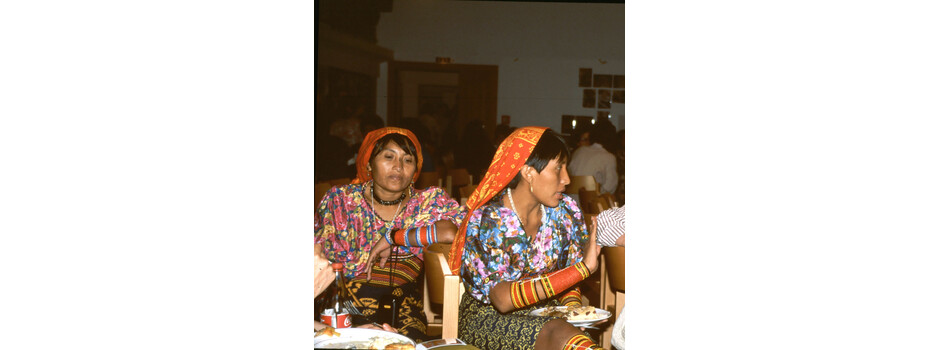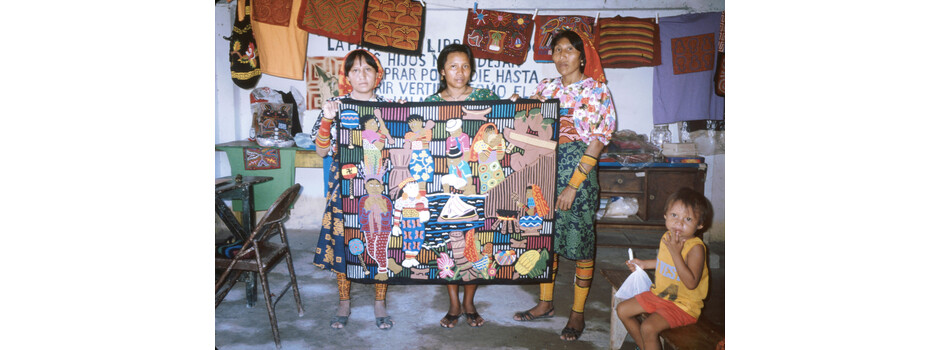Mola - a Traditional Textile from Panama
Published on July 27, 2020© Tijana Jakovljević-Šević
Have you ever heard of "Mola" textiles? I must admit that I did not until I dived in the preparation of the exhibition "Rück Blick Nach Vorne. 1989 - 2019 - 2030".* Then I learned that these objects, through a very specific textile technique, are produced by the Kuna from Panama and that numerous works in the field of ethnology / anthropology, folk art, art history and gender studies are written about them.
Molas are multi-layered objects consisting of two to seven layers of textile. The specificity of this technique is based on a combination of drawing, basting, cutting and sewing. First, the desired ornament is drawn on the upper layer of the fabric and then it is carefully basted. Slots about three millimeters long are made on both sides of the basted lines. The cut edge is bent about one millimeter wide inwards and sewn to the base, choosing the appropriate thread color, so that the seams are not visible. In case the item is made of several layers of textile, this process is repeated on each of them. In addition to this basic way of making ornaments, other textile techniques are included, such as appliqué and embroidery.
The ornaments that appear on the Molas come from the practice of body painting. Some authors state that this transfer of ornaments from the body to the textiles would not have developed if the Kuna had not exchanged coconuts for supplies arriving on merchant ships during the 19th century, including fabrics and various sewing accessories. Others, however, state that such a transition of motives occurred due to the insistence of the missionaries that the Kuna start wearing clothes that fit into the Western concept of clothing.
The design of Molas is based on the organization of ornaments in four or eight sets. The main ornaments are placed in the center of the fabric, while the background is filled with details, such as lines, circles and triangles, which are repeated. In addition to the ornaments, the choice of colors that create a strong contrast is important for the appearance of Molas. In order for each ornament to be better presented, great attention is paid to meticulousness in the production, which depends not only on the skill of the author, but also on the choice of material, which is why quality cotton is chosen.
Although the Kunas are making great efforts to protect their traditional way of life, observing their folk art, the influence of foreign elements on their cultural practice is clearly visible. Missionaries, anthropologists and other researchers, foreign doctors, volunteers, the military and tourists brought numerous elements that were incorporated into traditional Molas narratives. Today, in addition to ornaments depicting the flora and fauna of the local area or ritual and traditional activities, they also appear, such as modern means of transport or characters from popular culture and media.
During the 1960s, Molas began to be produced for commercial purposes as well. The demand for this colorful textile has encouraged Kunas women to start producing it for the global market as well. Due to their popularity and economic profitability, numerous copies that are not a product of the work of the Kunas began to appear. That is why Panama introduced a law in 1984 that protects folk art. Despite that, the market is flooded with fake Molas, which sale directly harms the main source of Kunas incomes.
However, the task of these textile items is not only to provide material income. Molas represent a significant segment of the Kunas culture by which this nation, especially women, constructs and displays their identity.
*The exhibition was held in the Museum of Women's Culture Regional-International from May to November 2019. (link)
References:
Bartra, Eli (ur.). 2003. Crafting Gender, Women and Folk Art in Latin America and the Caribbean. Duke University Press.
Franger, Gaby (ur.). 1995. Über-Lebens-Kunst. Frauenalltag auf Stoffbildern. Nürnberg.
Translation from the original Serbian "Mola"
to the exhibition "Rück Blick Nach Vorne"
back to "blog EN"
back to "home"
BLOG
blog EN
blog SR
blog DE
Kategorien DE:
"Portraits und Interviews"
"Rück Blick Nach Vorne"
"Literarisches Bufett"
"Vermittlung"









